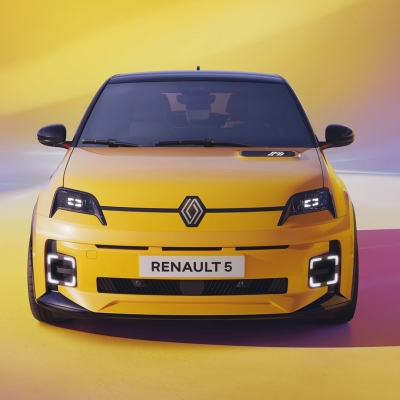The Renault 5: It’s Back – And It’s All-Electric
23/06/25
We’ve seen a wave of classic car names return to UK roads lately, but often in name only. Models like the Ford Capri are making a comeback in forms that feel quite different from what people remember. The Capri, once a sleek coupe, has reappeared as an electric SUV. It keeps the badge and a nod to its old paint job, but for many, that’s where the connection ends. The nostalgia is there, but only on the surface.
Renault’s approach feels more considered, and the new Renault 5 is a clear example of that. It's not the only classic name they're bringing back either. The Twingo, another iconic city car from Renault’s past, is also set to return. Although we’ve only seen a prototype so far and it's not due on the road until 2026, it follows the same philosophy. Renault is reviving familiar names in a way that respects their original character rather than simply reusing them.
Which brings us back to the Renault 5. The new Renault 5 holds a lot of resemblance to the original. Yes, it’s electric, but it hasn’t lost its soul. It’s not just about the styling, it’s the way it captures something genuinely familiar, without feeling like a gimmick or a throwback for its own sake.
How It Came to Be
When Luca de Meo became Renault’s CEO in 2021, he toured the design studio and wasn’t particularly wowed, until he noticed a model just sitting there. It was a modern reinterpretation of the Renault 5 by designer François Leboine, originally just a fun styling exercise. It was never meant for production, considered too retro to be taken seriously.
But de Meo saw something in it. He pushed it forward and gave the green light to turn it into a real car.
We first saw the concept version in 2021. It was supposed to arrive in 2023, but delays pushed the launch to 2025. Now, finally, it’s here—and yes, it looks a lot like that concept. Not watered down, not a half-hearted revival. This is Renault’s new main electric hatchback, not just a one-off or a collector’s toy. With a starting price of around £22,995, it’s clearly meant for everyday drivers, not just enthusiasts.
At launch, the Renault 5 offers a few different options depending on how much power, range, and tech you want. The entry-level model starts at £22,995 and comes with a 118bhp electric motor paired with a 40kWh battery, offering up to 190 miles of range. It includes 18-inch alloy wheels, a 7-inch digital gauge cluster, wireless phone mirroring, rear parking sensors, and LED lighting at both ends. Step up to the mid-range Techno trim, priced at £26,995, and you get a more powerful 148bhp motor with a larger 52kWh battery that boosts range to 248 miles. This version also adds features like adaptive cruise control, keyless entry, and a clever charge indicator integrated into the bonnet.
At the top of the range is the Iconic trim, which costs £28,995 and brings more comfort tech into the mix—heated front seats and steering wheel, lane-keeping assistance, and full parking assist. With the 148bhp setup, the Renault 5 does 0–62mph in under 8 seconds—not a hot hatch, but quick enough to feel lively around town.
The interior takes inspiration from the original Renault 5, though it’s very much designed for today’s driver. There are ribbed dash panels reminiscent of the early models, unusual seat shapes with floating side bolsters, and bold colour accents—like the bright yellow seat detailing. Not everyone will love the flair, but it's a refreshing change from the usual grey-on-grey interiors.
Materials are also thoughtfully chosen seat upholstery is made from recycled plastic bottles, and the overall vibe feels playful yet practical.
The entry-level model comes with a 10.1-inch infotainment screen, but Renault has made sure not everything is touchscreen-only. There are physical climate controls, tactile rocker switches, and a separate bar for quick-access settings—something many drivers will appreciate.
The Renault 5 is built on a new EV platform shared with models like the Clio and the Nissan Juke. But while it borrows some architecture, it’s not just a clone. Engineers focused heavily on driving dynamics—one reason it gets multi-link rear suspension instead of the simpler torsion beam used in the Clio. This should mean sharper handling and better ride comfort.
It’s assembled in Douai, France, with most of its suppliers located within 300km—part of Renault’s effort to keep the production footprint low.
At 3,922mm long, the Renault 5 is shorter than the Clio. That does mean the rear seats aren't exactly spacious. For taller passengers, it might feel tight back there. But for everyday use or urban driving, it’s more than workable.
Boot space stands at 277 litres, which is decent for a car of this size. Not groundbreaking, but enough for groceries, bags, or a weekend away.
The final version isn’t an exact replica of the 2021 concept, but the changes are subtle. The lighting signature up front has evolved: instead of diffused panels, the production version uses clear projector LED headlights. It’s still close to the original vision, though, which is rare when concept cars become reality.
The Renault 5 stands out not because it’s trying too hard to be modern—but because it dares to look back while moving forward. It doesn’t feel like a nameplate slapped on a random EV. It feels intentional, well thought out, and genuinely fun.
In a market full of sterile, soulless crossovers, this is something different. And for once, the nostalgia doesn’t feel fake.
For reservations and quotes
please call
our team on
01978 668920 or email us





